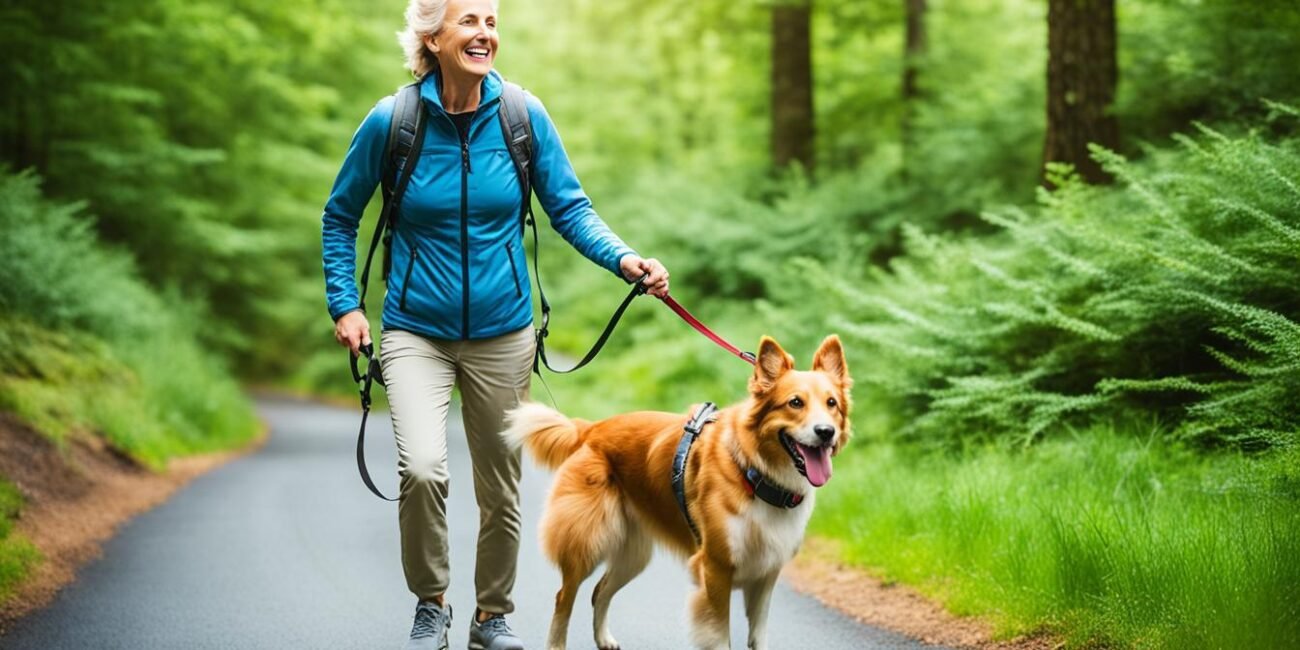Walking my dog is one of my favorite activities. Not only does it give us both some much-needed exercise, but it also allows us to spend quality time together and strengthen our bond. However, I’ve realized that simply going on the same monotonous walk every day can get boring for both of us. That’s why I’ve started incorporating some fun and engaging activities into our walks to make them more enjoyable for both of us. Here are some dog walking tips and ideas that have worked wonders for us, and I’m sure they’ll do the same for you and your furry friend.
Key Takeaways:
- By varying your walking route, you can add variety and new experiences to your walks.
- Letting your dog lead the way during walks not only keeps them engaged, but it also helps you understand their behavior and interests.
- Switching up your walking pace can add excitement and challenge to your walks.
- Incorporating quick training sessions during walks helps enhance your dog’s training and focus.
- Bringing treats along for mental stimulation and using them for quick games can make walks more enjoyable for your dog.
Teach Your Dog Proper Walking Etiquette
When it comes to walking your dog, proper etiquette is key. Not only does it ensure a pleasant and controlled walking experience, but it also promotes safety for both you and your furry companion. Here are some essential tips to teach your dog the right way to walk:
- Use the right walking equipment: Invest in a high-quality harness or leash that provides optimal control and comfort for your dog. This will help prevent unnecessary pulling and ensure a safer walking experience.
- Establish walking rules: Train your dog to walk beside you rather than pulling ahead. Use positive reinforcement techniques, such as treats and praise, to reinforce good behavior.
- Maintain walking control: Maintain a firm grip on the leash, keeping it short but not too tight. This will give you better control over your dog’s movements and prevent them from wandering off or approaching potential hazards.
- Practice leash manners: Teach your dog to walk calmly on a loose leash. If your dog starts pulling, stop walking and wait for them to calm down before resuming the walk. This helps them understand that pulling will not get them to their destination faster.
- Be consistent with training: Consistency is key when teaching proper walking etiquette. Set aside dedicated time for training walks and reinforce positive behaviors consistently. Over time, your dog will learn and become more comfortable with the expected walking behavior.
Remember, patience and positive reinforcement are crucial when training your dog to walk with proper etiquette. With consistency and practice, you’ll soon enjoy peaceful and enjoyable walks with your four-legged friend.
“A well-trained dog makes for a happy and harmonious walking experience.”
Walking Equipment Comparison
| Equipment | Description | Pros | Cons |
|---|---|---|---|
| Harness | A strap-like device that goes around the dog’s chest and back. |
|
|
| Leash | A long cord or strap used to control the dog’s movement. |
|
|
| Retractable Leash | A leash with a retractable cord or tape. |
|
|
Let Your Dog Explore and Sniff
When taking your dog for a walk, it’s important to remember that it’s not just about the exercise. Dogs experience the world through their senses, and one of their favorite activities is to explore and sniff their surroundings.
Allowing your dog to explore and take sniff breaks during walks is crucial for their mental stimulation and enjoyment. Not only does it provide them with a chance to satisfy their natural curiosity, but it also helps them engage with their environment and discover new scents and surroundings.
“Dogs have an incredible sense of smell, and exploring through sniffing is like reading a storybook for them.”
Experts recommend incorporating 2-3 sniff breaks throughout your walk. This means giving your dog the freedom to pause and investigate interesting smells, whether it’s a nearby tree, a patch of grass, or even a fire hydrant.
During these sniff breaks, it’s beneficial to let your dog take their time and follow their nose. Avoid rushing them or pulling them away from something they’re interested in. Remember, this is their opportunity to gather information about their environment and engage their senses.
“Letting your dog explore and sniff during walks is like giving them a chance to communicate and understand the world around them. It’s a form of mental exercise that is just as important as physical exercise.”
So, the next time you take your dog for a walk, embrace their natural curiosity and let them explore. Incorporate those sniff breaks, and observe how much joy and enrichment it brings to your furry friend’s life.
| Benefits of Letting Your Dog Explore and Sniff | Tips for Incorporating Sniff Breaks |
|---|---|
|
|
Letting your dog explore and sniff is not only beneficial for their mental well-being, but it also strengthens the bond between you and your furry companion. So, go ahead, embrace their natural instincts, and make every walk a sniff-ari for your dog!
Let Your Dog Lead the Way
Letting your dog choose the direction of the walk is not only enjoyable for them, but it also provides valuable insights into their behavior and interests.
Walking with your dog is an excellent opportunity to strengthen the bond between you and your furry companion. By giving them the freedom to lead the way, you allow them to take control and make the walk more engaging and exciting.
As your dog leads, pay close attention to their body language and behavior. Are they curious about certain areas? Do they veer towards specific scents or landmarks? Understanding their interests during the walk can help you tailor their training routine and provide them with the mental stimulation they crave.
“Letting your dog choose the direction of the walk is like giving them a voice. They feel empowered and engaged, making the walk a more enriching experience for both of you,” says Sarah Thompson, a professional dog trainer.
Walking aimlessly without a set route or destination can be an exciting adventure for you and your dog. It creates an element of surprise and allows them to explore new surroundings and scents.
So next time you go for a walk, loosen the leash and let your dog take the lead. You’ll be amazed at the joy and fulfillment it brings to both of you.
| Benefits of Letting Your Dog Lead the Way | How It Helps Understand Your Dog’s Behavior |
|---|---|
|
|
Remember, every walk is an opportunity for you to understand your dog better and make their outdoor experiences more enjoyable. Let them lead the way and embark on a journey of discovery together.
Switch Up Your Walking Route
Changing walking routes is a great way to add variety and excitement to your dog’s daily walks. Exploring new neighborhoods and environments not only provides fresh experiences for your furry friend but also keeps the walks engaging and interesting for both of you.
By switching up your walking route, you introduce different sights, sounds, and smells for your dog to explore. This can stimulate their senses and keep them mentally and physically active during the walk. It also prevents them from getting bored with the same old routine.
One of the benefits of changing walking routes is the opportunity to discover new parks, trails, and green spaces in your area. This allows you to expose your dog to different terrains and environments, which can be mentally stimulating and provide them with a more enriched walking experience.
Benefits of Changing Walking Routes:
- Provides new experiences and stimuli for your dog
- Prevents boredom and monotony
- Offers opportunities for mental and physical stimulation
- Allows you to explore different neighborhoods and parks
- Keeps walks exciting and engaging for both you and your dog
Tips for Switching Up Your Walking Route:
- Plan your route in advance to ensure you explore new areas.
- Take note of interesting parks or trails that you come across during your walks.
- Ask fellow dog owners or local pet communities for route recommendations.
- Consider scheduling longer walks on weekends to allow for more exploration time.
- Use GPS or map apps to track your route and ensure you don’t get lost.
Remember to prioritize the safety and comfort of both you and your dog when exploring new routes. Pay attention to the surroundings, traffic conditions, and any potential hazards. With a bit of planning and creativity, you can make each walk a new adventure for you and your canine companion.
Get ready to discover the world together, one route at a time!
Vary Your Walking Pace
Changing your walking pace can add excitement and variety to your dog’s daily walks. It is important to observe your dog’s preferences and adjust your pace accordingly to ensure they have an enjoyable experience. Start with a slower pace to warm up and let your dog explore their surroundings. Then, gradually increase the pace to brisk walking, providing them with a good workout and mental stimulation.
If your dog enjoys a more energetic walk, you can even incorporate jogging or running into your routine. This not only helps burn off excess energy but also strengthens their muscles and promotes cardiovascular health.
“Varying your walking pace not only adds physical challenge to your dog’s routine but also keeps their mind engaged. It allows them to experience different environments and scents, making their walks more interesting and enjoyable.”
Remember to pay attention to your dog’s cues and body language. If they seem tired or fatigued, slow down or take a break. On the other hand, if they show signs of enthusiasm and excitement, you can pick up the pace to match their energy level. By adjusting your walking pace, you create a dynamic and stimulating walking experience that caters to your dog’s needs.
Tips for Varying Your Walking Pace:
- Start with a slower pace for warm-up and exploration.
- Gradually increase the speed to brisk walking for a workout.
- Incorporate jogging or running for more energetic dogs.
- Observe your dog’s cues and adjust the pace accordingly.
- Take breaks when needed and allow your dog to rest.
By varying your walking pace and adapting it to your dog’s preferences, you can make their daily walks more enjoyable, physically stimulating, and mentally engaging.
Incorporate Quick Training Sessions
During your walks with your furry companion, take advantage of the time to incorporate quick training sessions. This not only helps improve their obedience and focus but also provides mental stimulation and strengthens the bond between you and your dog.
Basic obedience commands, such as sit, stay, and heel, can be easily practiced during walks. Start by reinforcing the commands your dog is already familiar with, and gradually introduce new commands to keep their training varied and engaging.
Training during walks helps your dog develop impulse control and obedience in distracting environments. It enables them to generalize their obedience skills and respond reliably even when there are distractions around.
Remember to keep the training sessions short and positive, rewarding your pup with treats and praise for their efforts. Using a clicker or verbal cues can also help reinforce their understanding of the commands.
Benefits of Training During Walks
- Improved Focus: By practicing obedience commands during walks, you can strengthen your dog’s ability to focus on you even amidst distractions. This is particularly helpful when encountering other dogs, people, or exciting stimuli during your walks.
- Mental Stimulation: Incorporating training exercises during walks provides mental stimulation for your dog, helping to prevent boredom and destructive behaviors. It challenges their problem-solving skills and keeps their minds engaged.
- Better Leash Control: Through training during walks, you can teach your dog proper leash manners and control. This includes walking calmly beside you without pulling or lunging, ultimately making your walks more enjoyable and relaxed.
By utilizing your walk time for training, you can create a well-rounded and fulfilling experience for both you and your furry friend.
“Incorporating training exercises during walks provides mental stimulation for your dog, helping to prevent boredom and destructive behaviors.”
Bring Treats for Mental Stimulation
Bringing treats along for your walks is a great way to make them more enjoyable for your dog. Not only do treats serve as a reward for good behavior, but they can also provide mental stimulation and engagement during your walks. Here are a few ideas on how to incorporate treats for maximum fun:
- Play Hide and Seek: Hide small treats along your walking route for your dog to find. This game taps into their natural scavenging instincts and keeps them mentally stimulated throughout the walk.
- Engage Their Sense of Smell: Toss treats into the grass or under bushes for your dog to sniff out. This encourages them to use their sense of smell and adds an element of excitement to the walk.
- Training Exercises: Use treats to practice basic commands or tricks during your walk. This not only provides mental stimulation but also reinforces their training and obedience skills.
Remember to choose treats that are suitable for your dog’s dietary needs and preferences. Not all dogs have the same taste preferences, so it’s important to find treats that your furry friend finds enticing.
Expert Tip: Treats are not only a great source of mental stimulation but also an opportunity to bond with your dog. Use treat time as a chance to reinforce positive behaviors and create a stronger connection with your four-legged companion.
By incorporating treats into your walks, you not only make them more enjoyable for your dog but also provide them with mental stimulation and engagement. So don’t forget to pack some tasty rewards for your next walk!
Visit Local Parks
Taking your dog to local parks can be a fantastic way to enhance your walks and provide new opportunities for exploration and socialization. Parks offer a variety of smells, sights, and sounds that can engage your dog’s senses, making the experience more exciting and enriching.
Socializing during walks is important for dogs to develop their social skills and build positive interactions with other dogs and people. In a park setting, you can allow your dog to meet and interact with new furry friends, helping them develop confidence and overcome any shyness they may have.
When visiting a park, ensure you abide by any rules or regulations that may be in place, such as leash requirements or designated dog-friendly areas. This ensures the safety and enjoyment of all park visitors, including your four-legged companion.
| Benefits of Visiting Local Parks | Activities to Enjoy |
|---|---|
|
|
Remember to always prioritize the safety and comfort of your dog during park visits. Keep an eye on their interactions with other dogs and be aware of any potential hazards in the area. By incorporating local parks into your walks, you can make them more enjoyable and provide your dog with a fun-filled adventure.
Walk with Friends and Their Dogs
Walking with friends and their dogs can bring a whole new level of enjoyment to your daily walks. It not only provides companionship for both you and your own dog but also gives your furry friends the opportunity to socialize and play together.
When you walk with friends and their dogs, it creates a sense of community and shared experiences. It’s a chance to bond with fellow dog owners and exchange stories, tips, and tricks. Plus, having someone to walk with can make the time fly by and make those longer walks more exciting.
Group walks offer a unique opportunity for your dog to interact with other dogs, which is essential for their social development. It helps them learn proper socialization skills, practice good manners, and build confidence around different personalities and energy levels.
Here’s a simple guide on how to organize a group walk with friends and their dogs:
- Choose a convenient time and meeting point for everyone.
- Notify your friends and ask them to RSVP for the walk.
- Plan a route that is suitable for all dogs and their fitness levels.
- Ensure all dogs are well-behaved and up-to-date on vaccinations.
- Bring poop bags and remind everyone to clean up after their dogs.
- Encourage positive interactions between the dogs and monitor their behavior.
Walking with friends and their dogs is not only beneficial for your furry companions but also for you. It creates a support system where you can share the joys and challenges of dog ownership, while also promoting a healthier and more active lifestyle for everyone involved.
So why not gather your friends, put on those walking shoes, and hit the trails together? Enjoy the company, the conversations, and the laughter while your dogs frolic and explore. It’s a win-win situation for everyone involved.
Remember, a group walk isn’t just about exercise. It’s about building connections, fostering relationships, and creating memories that will last a lifetime.
Try New Activities and Games
Adding activities and games to your walks can make them more engaging and stimulating for your dog. It’s important to provide both mental and physical stimulation to keep them happy and healthy. Here are some ideas to try during your walks:
Agility Training
Agility training is a popular dog sport that involves navigating obstacle courses. It not only challenges your dog physically but also helps improve their coordination and focus. Set up a mini obstacle course in a nearby park or your backyard and guide your dog through it. You can use objects like cones, tunnels, and hurdles to create a fun and challenging course. Remember to start with easy obstacles and gradually increase the difficulty as your dog progresses.
Fetch
Playing fetch during your walks is a classic game that provides both physical exercise and mental stimulation for your dog. Bring along a ball or a Frisbee and throw it for your dog to retrieve. This game allows them to use their natural hunting instincts and keeps them active. It’s also a great bonding activity between you and your furry friend.
Dog Parkour
Dog parkour, also known as urban agility or street agility, is a growing trend in the dog sports world. It involves navigating urban environments and using natural obstacles creatively. Encourage your dog to jump on benches, balance on walls, and climb stairs during your walks. This type of activity challenges their problem-solving skills and builds confidence.
“Adding dog sports and games to your walks not only keeps your dog physically fit but also provides mental stimulation and prevents boredom.” – Expert Dog Trainer
Remember to choose activities that are suitable for your dog’s breed, age, and physical abilities. Always prioritize their safety and well-being during these activities. By incorporating these new activities and games into your walks, you’ll make them more enjoyable and fulfilling for both you and your canine companion.
Conclusion
After exploring various tips and ideas, I conclude that making walks enjoyable for you and your dog is crucial for their well-being and training. By incorporating these strategies, you can transform your daily walks into bonding experiences that both you and your furry friend will cherish.
Remember to prioritize your dog’s needs and preferences during walks. Allow them the freedom to explore and sniff, as it provides mental stimulation and keeps them engaged. Letting your dog lead the way also helps you understand their behavior better and tailor their training accordingly.
Adding variety to your walking routes and changing the pace keeps the walks exciting for your dog. Additionally, incorporating quick training sessions during walks not only reinforces their obedience but also enhances their focus and impulse control.
Bringing treats along for mental stimulation and visiting local parks for socialization are other effective ways to make walks enjoyable. Walking with friends and their dogs can provide companionship and encourage social interactions. Finally, trying new activities and games during walks keeps your dog physically and mentally stimulated.
FAQ
How can I make walks enjoyable for me and my dog?
There are several ways to make walks enjoyable for you and your dog. You can vary your walking routes, change your walking pace, incorporate training sessions, bring treats for mental stimulation, visit local parks, walk with friends, and try new activities and games.
What walking etiquette should I teach my dog?
It’s important to teach your dog to walk next to you instead of pulling ahead. Using the right equipment, such as a harness, can also ensure their comfort and safety during walks.
How often should I let my dog explore and sniff during walks?
It’s recommended to incorporate 2-3 sniff breaks throughout your walk to keep your dog engaged and allow them to discover new scents and surroundings.
Should I let my dog choose the direction of the walk?
Yes, giving your dog the freedom to choose the direction of the walk can make it more interesting and enjoyable for them. It also helps you understand their behavior and interests.
How often should I change my walking route?
Experts suggest switching up your walking routes regularly to provide new experiences for your dog and keep the walks exciting and engaging.
How can I vary my walking pace?
You can start with a slower pace, move on to brisk walking, and even incorporate jogging if your dog enjoys it. Observing your dog’s preferences is important to ensure they have an enjoyable experience.
Can I incorporate training during walks?
Yes, using walk time to practice basic obedience commands, such as sit, stay, and heel, can enhance your dog’s training and focus. It also helps them develop impulse control and obedience in distracting environments.
Should I bring treats during walks?
Yes, bringing treats along for your walks is a great way to make them more enjoyable for your dog. You can use treats for quick games like hide and seek or toss them into the grass to encourage your dog to use their sense of smell.
How can visiting local parks enhance our walks?
Taking your dog to local parks adds excitement to walks. It allows them to explore new smells and locations, socialize with other dogs, and enjoy the extra space and company.
Is walking with friends and their dogs a good idea?
Yes, inviting a friend to join you on walks with their dog can make it more enjoyable for everyone. It provides companionship for both you and your dog while allowing the dogs to socialize and play together.
What activities and games can I try during walks?
Adding activities and games to your walks can make them more engaging and stimulating. Consider introducing agility training, fetch, or even dog parkour to keep your dog physically and mentally challenged.










No Comment! Be the first one.